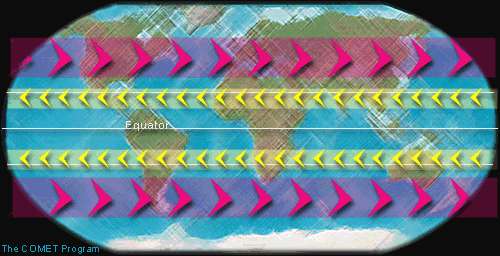 description
description Why do tropical cyclones go where they go? What systems in the atmosphere make them move?
There are many factors involved, but some of the main ones are wind belts, highs, and lows. On this page, you'll learn how these three combine to guide tropical cyclones on their deadly paths of destruction.
The journeys of tropical cyclones are guided by two sets of wind belts around the world. The tropical Easterlies blow from east to west in two tropical belts on each side of the equator. The midlatitude Westerlies blow from west to east in two wide belts half way between the equator and the poles.
Question: Which belts do you think control tropical cyclones when they are first born? (Choose an answer.)
Question: Which belts do you think usually control tropical cyclones near the ends of their life cycles? (Choose an answer.)
Aside from these belts, there are other things that control the movements of tropical cyclones. High and low pressure systems are like traffic police for tropical cyclones. They, along with the easterly and westerly belts, create patterns of flow in the atmosphere that control the movements of tropical cyclones.
This map shows a low pressure system (marked by the red "L") centered over the eastern United States and a high pressure system (marked by the blue "H") centered over the western North Atlantic Ocean. Notice how the air circulates counterclockwise around the low and clockwise around the high.
In the Southern Hemisphere, the flow is opposite: clockwise around lows and counterclockwise around highs.
Study this map with hurricanes A and B. Notice how hurricane A is positioned. It is southeast of the low and west-southwest of the high.
Question: Judging from the flow patterns, where do you think the high and low pressure systems will push hurricane A? Hurricane A will probably move toward the... (Choose an answer.)
Question: Where do you think the high and low pressure systems will push hurricane B? Hurricane B will probably move toward the... (Choose an answer.)
Of course, hurricanes aren't the only things that move in the atmosphere. High and low pressure systems are also always on the move. This is one reason why it can be so hard to predict where a hurricane might go next.
Wind belts, highs, and lows all help direct the journeys of tropical cyclones. This map shows the typical paths of hurricanes, cyclones, and typhoons. Study the following picture and try to answer the questions below.
Question: Tropical cyclones usually start out moving toward the... (Choose an answer.)
Question: Tropical cyclones that cross the Tropic of Cancer usually move toward the... (Choose an answer.)
Question: What do tropical cyclones never cross? (Choose an answer.)Congratulations, you have reached the end of this mini-module on Hurricanes and Tropical Cyclones.